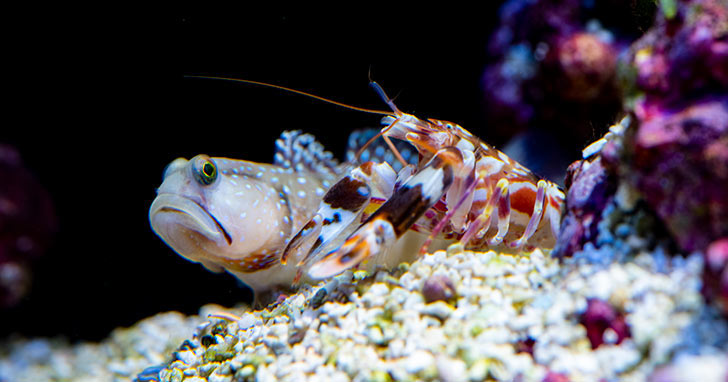|
Much like anemones and clownfish, pistol (snapping) shrimp of the genus Alpheus and certain bottom-dwelling gobies share a symbiotic relationship in which each partner benefits.
Pistol shrimp are named for the loud snapping sound and startling jet of water which result from the rapid closing of their modified claw. This behavior is primarily a defense mechanism against predatory fish. Pistol shrimp are also known for burrowing into sand, mud, and gravel with their front claws. However, they prefer to burrow in lagoons and reef edges - areas with little to no cover from predators. This precarious housing location, combined with their relatively poor eyesight, requires pistol shrimp to solicit the help of certain gobies, most frequently Stonogobiops,
Amblyeleotris, and Cryptocentrus from the Indo-Pacific.
The perfect partnership
As the goby uses the shrimp's burrow for protection from predators, it also acts as "eyes" for the pistol shrimp. During the day, the goby hovers above the burrow, feeding and interacting with other gobies. Meanwhile, the shrimp uses its antennae to stay in constant contact with the goby's tail while searching for food (detritus, tiny crustaceans and worms) and maintaining the burrow opening. If a predatory fish approaches, the goby flicks its tail several times, alerting the shrimp to retreat into the burrow. If the predator comes within striking distance, the goby will dart headfirst into the burrow. During the night, the two simply rest together in the burrow.
Make this relationship work in your aquarium
To bring this interesting, undemanding pistol shrimp-goby relationship to your home aquarium, you must have a well-established aquarium of 30 gallons or more with
live rock that does not contain overly active and aggressive inhabitants. You will also need to provide at least two inches of fine live sand or
gravel. Initially, feed small quantities of meaty foods such as vitamin-enriched
mysis shrimp and brine shrimp several times per day. After several weeks, gobies should accept prepared flake or
pellet foods developed for carnivorous marine fish. |





